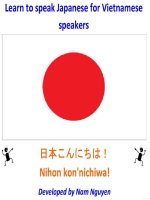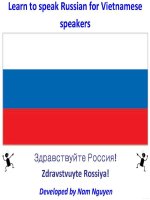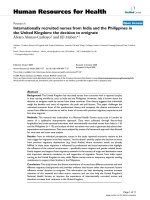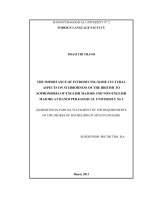Study on factors infuencing the decision to study abroad for vietnamese student
Bạn đang xem bản rút gọn của tài liệu. Xem và tải ngay bản đầy đủ của tài liệu tại đây (1.59 MB, 112 trang )
STUDY ON FACTORS INFLUENCING THE DECISION TO STUDY
ABROAD FOR VIETNAMESE STUDENT
In Partial Fulfillment of the Requirements of the Degree of
MASTER OF BUSINESS ADMINISTRATION
In International Business
By
Ms: To Tran Phuong Thao
ID: MBA05041
International University - Vietnam National University HCMC
March 2014
INTERNATIONAL UNIVERSITY
SCHOOL OF BUSINESS
SOCIALIST REPUBLIC OF VIETNAM
Independence - Freedom - Happiness
ASSURANCE QUALIFIED THESIS
Student’s Name: TO TRAN PHUONG THAO
Student ID:
MBA05041
Title of Thesis:
STUDY ON FACTORS INFLUENCING THE DECISION TO STUDY
ABROAD FOR VIETNAMESE STUDENT
Advisor:
PHD. PHAN TRIEU ANH
I assure that the content of this thesis has been qualified all requirements for a
research paper and able to participate in the final thesis defense.
Approved by
STUDY ON FACTORS INFLUENCING THE DECISION TO STUDY
ABROAD FOR VIETNAMESE STUDENT
In Partial Fulfillment of the Requirements of the Degree of
MASTER OF BUSINESS ADMINISTRATION
In International Business
By
Ms: To Tran Phuong Thao
ID: MBA05041
International University - Vietnam National University HCMC
Under the guidance and approval of the committee, and approved by all its
members, this thesis has been accepted in partial fulfillment of the requirements for
the degree.
Approved:
---------------------------------------------Chairperson
---------------------------------------------Committee member
---------------------------------------------Committee member
---------------------------------------Committee member
---------------------------------------Committee member
---------------------------------------Committee member
ACKNOWLEDGEMENT
First and foremost, it is a pleasure to express my sincere gratitude to many people
who made this thesis possible.
It is difficult to express my gratitude to my advisor – PHD. Phan Trieu Anh. He
spent much time to explain details, give useful advice as well as identifies the
mistakes of my writing content. With his enthusiasm help and whole-hearted
instruction, I complete the research well.
In addition, I would like to thank my colleagues in my company and in MBA class
for supporting me in giving advice about my thesis. Their advice is valuable to me.
I am especially thankful to students who spend time to have interview with me and
take survey with 58 questions. If without their help, I could not finish this study.
Last but not least, I really thank my mother and husband. They always support and
help me take care of family jobs and they are always together with me on the learning
journey.
TO TRAN PHUONG THAO – AUGUST 2014.
i
Plagiarism Statements
I would like to declare that, apart from the acknowledged references, this
thesis either does not use language, ideas, or other original material from anyone; or
has not been previously submitted to any other educational and research programs or
institutions. I fully understand that any writings in this thesis contradicted to the
above statement will automatically lead to the rejection from the MBA program at
the International University – Vietnam National University Ho Chi Minh City.
ii
Copyright Statement
This copy of the thesis has been supplied on condition that anyone who consults it
is understood to recognize that its copyright rests with its author and that no
quotation from the thesis and no information derived from it may be published
without the author’s prior consent.
© To Tran Phuong Thao/ MBA05041
iii
TABLE OF CONTENT
CHAPTER 1 ............................................................................................................ 1
INTRODUCTION ................................................................................................. 1
1.1 Background .................................................................................................. 4
1.2 Rationale ...................................................................................................... 6
1.3 Research objective ....................................................................................... 6
1.4 Research question ....................................................................................... 7
1.5 Scope and limitation .................................................................................... 7
1.6 Significance and Implication ....................................................................... 7
CHAPTER 2 ............................................................................................................ 8
LITERATURE REVIEW ...................................................................................... 8
2.1 Concept of international education ............................................................. 8
2.2 Concept of international student ................................................................. 8
2.3 Theory of Planned Behavior ....................................................................... 9
2.4 Push-Pull model of International student flow ......................................... 11
2.5 Factor that influence to international student’s decision .......................... 13
2.6 Influencing factors of student mobility trend. ........................................... 15
2.6.1 Benefit of international education .................................................... 15
2.6.2 Significant people ............................................................................ 16
2.6.3 Institution characteristics ................................................................. 18
2.6.4 Immigration and employment prospects .......................................... 19
2.6.5 Barriers factors have influence to student’s decision. .................... 21
2.7 Conceptual framework. ............................................................................. 24
iv
CHAPTER 3 .......................................................................................................... 24
RESEARCH METHODOLOGY ....................................................................... 24
3.1 Qualitative and quantitative research ........................................................ 26
3.2 Research process ....................................................................................... 27
3.3 Measurement ............................................................................................. 28
3.4 Questionnaire design ................................................................................. 28
3.4.1 Qualitative study .............................................................................. 29
3.4.2 First draft questionnaires – Pilot study ............................................ 29
3.5 Sampling ................................................................................................... 29
3.6 Questionnaire’s Design ............................................................................. 30
CHAPTER 4 .......................................................................................................... 32
DATA ANALYSIS AND FINDINGS ............................................................... 32
4.1 Demographic details ................................................................................. 32
4.1.1 Gender .............................................................................................. 33
4.1.2 Age ................................................................................................... 33
4.1.3 Degree which the students want to study abroad ............................. 33
4.1.4 Income. ............................................................................................. 34
4.1.5 Student’s major of study .................................................................. 35
4.1.6 Student’s country of study ............................................................... 36
4.1.7 Source of information ...................................................................... 37
4.2 Descriptive analysis .................................................................................. 38
4.2.1 Student’s choice for studying abroad ................................................... 39
4.2.2 Personal growth factors ...................................................................... 39
4.2.3 Value of degree ................................................................................ 40
4.2.4 Social link factors. ............................................................................... 41
4.2.5 Institutional factors ............................................................................. 43
v
4.2.6 Immigration and Employment ......................................................... 44
4.2.7 Barrier factors ................................................................................... 45
4.3 Reliability analysis .................................................................................... 46
4.4 Exploratory Factor Analysis (EFA) .......................................................... 47
4.4.1 EFA for independent variables ........................................................ 47
4.4.2 EFA for dependent variables ........................................................... 51
4.5 One Sample T Test .................................................................................... 52
4.6 Correlation testing ..................................................................................... 54
4.7 Regression analysis ................................................................................... 57
4.8 ANOVA test .............................................................................................. 59
4.8.1 Difference of gender about the student’s decision making .............. 59
4.8.2 Difference of 5 different income groups .......................................... 59
4.8.3 Difference of friend group ............................................................... 61
CHAPTER 5 .......................................................................................................... 62
DISCUSSION, IMPLICATION AND RECOMMENDATION ........................ 62
5.1 Discussion ................................................................................................. 62
5.2 Implication ................................................................................................. 63
5.2.1 What to communicate ...................................................................... 63
5.2.2 Who to communicate ....................................................................... 64
5.2.3 How to communicate ....................................................................... 65
5.3 Recommendation for future research ........................................................ 66
vi
List of Tables
Table 1: Vietnamese students in the United States from 1980s to 1990s
5
Table 2: Top 5 nationalities in Australia
6
Table 3: Factor have influence the student’s decision
22
Table 4: Comparison between qualitative research and quantitative research
25
Table 5: Descriptive Statistics of decision making
39
Table 6: Descriptive Statistics of personal growth factors
40
Table 7: Descriptive Statistics of degree value
41
Table 8: Descriptive analysis of social link factors
42
Table 9: Descriptive Statistics of institutional factors
43
Table 10: Descriptive Statistics of Employment and Immigration factor
44
Table 11: Descriptive Statistics of barrier factors
45
Table 12: Reliability test
47
Table 13: Independent variables – KMO
48
Table 14: Independent variables Rotated component matrix
48
Table 15: Dependent variables – KMO
51
Table 16: Dependent variable Total Variance Explained
51
Table 17: Dependent variable Component Matrix
52
Table 18: Means of 6 factors groups
52
Table 19: Mean comparison with test value 3.0
53
Table 20: Correlation analysis for dependent and independent variables
55
Table 21: Model Summary
57
Table 22: ANOVA
57
vii
Table 23: Mean difference between 6 factors
58
Table 24: Household income
60
Table 25: Difference of friend group with decision of studying abroad
61
viii
List of Figures
Figure 1: Key drivers of destination choice
4
Figure 2: Theory planned behavior (TPB) of Ajzen (1991)
10
Figure 3: Peterson’s (2003) model of the decision to study abroad
11
Figure 4: Judith Eder, Wayne W.Smith and Robert E. Pitts model
13
Figure 5: Conceptual framework of the student’s decision making process
23
Figure 6: Research process
26
Figure 7: Percentage by gender
32
Figure 8: Percentage by age
33
Figure 9: Percentage by educational level
34
Figure 10: Percentage by income level
35
Figure 11: Percentage by student’s study major
35
Figure 12: Percentage by interested country
36
Figure 13: Percentage by source of information on study abroad
37
ix
ABBRERIATE
1. Organization for Economic Cooperation and Development (OECD)
2. Theory Planned Behavior (TPB)
3. Attitude toward behavior (AB)
4. Subject norms (SN)
5. Perceived Behavior Control (PBC).
6. Vietnam Ministry of Education and Training (MOET)
x
ABSTRACT
The purpose of this study was to explore the factors influencing student’s
decision to study abroad. This study also compared the most influencing factors to
their decision. The synthesis model is developed to aim explanation the student’s
decision making process. The influential factors include in personal growth, degree
value, institutions, immigration and employment, social links and barrier factors. The
research samples comprises 204 students from the different areas in Vietnam who are
those having intention for studying oversea purpose in the future.
The main research method applied in this study was quantitative study. Through
regression and ANOVA analysis of variance and one sample T test, the results
showed that the most influencing factors are personal growth, degree value,
institutions, and social links and barrier factors. Results also indicated that there were
similarities and differences leading to the student’s decision by family income, gender
and friends connection studying abroad.
xi
This page is intentionally left blank
xii
CHAPTER 1
INTRODUCTION
This chapter will describe the background of the study which provides fact and
figures of student mobility trend overseas. Next, it will provide some statistic data
about number of students studying many worldwide countries in the recent years in
Vietnam. Then, it will mention to the study object, research question and significant
of this study. Finally, it ends with the scope and limitation of the research.
1.1 Background
The number of students for participating international education over the last few
decades is increasing dramatically, even despite the global economic downturn of
recent years. The Organization for Economic Cooperation and Development (OECD)
reports that 3.7 million of international students seeks opportunities for studying
overseas, which shows 75% increase since 2000 (OECD, 2011). With dramatic
expansion of students participated in international education, many researches
represented many reasons have influence to the increasing trend such as study on
student’s motivation and purposes for studying abroad. The global trend with the field
of higher education has brought many competitors (Ivy, 2001), who are involved in
attracting many international students (Nicholls, Harris, Mogan, Clark & Sims, 1995;
Soutar & Turner, 2002). The Unites States is always the most favorite destination for
international students with 22% (Verbik and Lasanowski, 2007). In 2009/2010, there
were 690,923 international students studying in United States (Open Doors, 2010).
Other countries such as Australia, Canada, and UK are facing competition together in
attracting international students.
1
In Asian countries such as Korean, China and Vietnam, students seek overseas
educational opportunities going deep into their culture and the fact that there is not
any alternative way to get success or good career by getting prestigious degree.
Micheal Seth, Korean history professor in James Madison University (United State)
said that” The truth 50 years ago and still right now”. It can say that Vietnam is one of
countries in recent years with number of students going to study abroad increasing
dramatically. In USA, Vietnam is among top ten countries; in Australia, Vietnam is
top fourth with more students.
Vietnam is a new Asian tiger and has one of growing economics in the world.
Currently, 45% of the population is under the age of 25, which means a young
generation, growing population will continue to demand increased access to tertiary
education. Integration with international education is becoming global trend
especially in Vietnam; a country has slow education system compared with developed
countries in the world. Today, over two million Vietnamese students are enrolled in
tertiary studies. This will continue to increases a result of the growing youth
population and economic expansion. According to the Vietnam Ministry of Education
and Training (MOET), the number of Vietnamese student overseas has increased for
the recent years. In 2000, just 10,000 students choose to go abroad for study purpose.
In 2012, there are more than 100,000 Vietnamese students studying in 49 countries
and territories. Majority of study abroad are self-financing, a ten-fold increase
compared to a decade ago and a limited number financial support from both
Vietnamese government and host institutions. Number of students study in Australia
with the highest rate nearly (25%), followed by USA (16%), China (13%). The trend
of self-financing studying abroad is to focus on Undergraduate sector. For example,
2010-2011, nearly 15 thousand students studying in US, among them are 11,054
2
students for undergraduate program, 2,420 students are for graduate program and
remains are for other sector as high school and vocational courses. Australia, US,
Britain, Canada and France were market entrants and they still continue promotional
campaigns to attract Vietnamese students. In the recent years, emerging education
market such as Singapore, New Zealand, Malaysia, Thailand, South Korea and Japan
are increasing effort to encourage Vietnamese students by offering many number of
scholarships, organizing many education exhibitions and recruitment activities.
Recently, the top five study destination countries are Australia, US, China, Singapore
and UK.
Regarding to the purpose of studying abroad, there are many various factors
influencing to decide studying abroad. Traditionally, one of factors was expectation to
raise the graduate’s economic and social status, especially within higher education
sector when home country may lack the supply of training for the specialized areas;
seeking opportunities to personal development in the foreign studying environment.
In addition, the close relationship between host and home countries has played
important role in student’s decision studying abroad (Mazzarol & Soutar, 2002). With
a rapid economic developments, young generation have deep understanding when
choosing to study in many different countries. “Push” and “pull” factors are link in
affecting to student’s decision studying abroad. (Mazzarol & Soutar, 2002; Maringe
& Carter, 2007; Li & Bray, 2007).The push factors refers due to motivation factors
from home country or individual factors and pull factors are from source of host
country which affect to student’s studying purpose. Many researchers found that the
student’s decision making process is extensive and complex when they must consider
cautiously for their studying abroad (Chen, 2008; Cubillo et al, 2006; Soutar &
Turner, 2002)
3
Following to figure 1 with the information from IDP, the author see that there are
many factors which motivate students choose to study in abroad. The important
factors are quality of education, international recognition of qualification,
employment opportunities after graduation.
Ease of obtaining a student visa
Distance from home country
Family / friends living or…
Institution location
Ability to work part-time
Lifestyle
Availability of scholarships
Migration/ PR opportunities
Safety
Affordability
Employment opportunities…
Home country recognition of…
International recognition of…
Quality of education
0%
Australian bound students
All student
5%
10%
15%
20%
Figure 1: Key drivers of destination choice
(Source: IDP Buyer Behaviour Research, Prospect Research 2010, Forethought
Research, April 2012 – Preliminary Findings)
1.2 Rationale
Currently, Vietnam is one of the fastest growing markets of international students
studying in many worldwide countries. Over the past decades, the number of
Vietnamese in US has increased more than 6 six fold from 1,200 students in
1997/1008 to nearly 13,000 in 2008/2009. With dramatic increase, Vietnam is placed
in top ten countries with large international students in US.
In 2011 and 2012, 15,572 students from Vietnam are studying in the United States.
It rises in 4.6% from the previous year. Vietnam is the eighth leading countries with
students coming to the United States. Vietnamese students choose to study
undergraduate level with 72.2%, 17% for graduate level, 5.5% for other and 5.2% for
4
vocational course. Following to report on International Educational Exchange,
number of Vietnamese students have steady increase throughout the 1980s and 1990s.
Table 1:
Number of Vietnamese students in the United States from 1980s to 1990s
Year
Number of students
from Vietnam
Number
change
previous year
of
Number of US
from study
student
abroad
going
to
Vietnam
2011/12
15,572
4,6%
n/a
2010/11
14,888
13,5%
881(up 28,4%)
2009/10
13,112
2,3%
686 (up 2.1%)
2008/09
12,823
46,2%
672
2007/08
8,769
45,3%
652
2006/07
6,036
31,3%
550
2005/06
4,597
25,3%
390
2004/05
3,670
16,0%
346
2003/04
3,165
16,3%
283
2002/03
2,722
7,5%
286
2001/02
2,531
25,2%
218
2000/01
2,022
-10,8%
188
1999/00
2,266
42,8%
142
1998/99
1,587
-
95
(Source: Open doors: Report on International Educational Exchange, published
annually by IIE with support from the U.S Department of State’s Bureau of
Educational and Cultural Affairs)
5
Australia is one of the favorite destinations for Vietnamese students in recent years.
Following to information source from Australian Consulate General, as at 30 June
2012, 15,500 Vietnamese Student visa holders were in Australia, representing 5.0 per
cent of all international students in Australia. In 2011–2012, 8,161 student visas were
granted to Vietnamese nationals up 14 per cent on 2010 - 2011 while this exceeds the
1.0 per cent overall rise in student visas over the same period. This places Vietnam in
4th position with number of students in Australia by Australian Education
International’s source.
Table 2: Top 5 nationalities in Australia
The Top 5 nationalities contributed 52.1% of Australia’s total enrolments
Growth
Share of all
Nationality
China
India
Republic of Korea
Vietnam
Thailand
Other nationalities
All nationalities
2012
149,577
53,929
27,562
22,423
20,142
240,119
513,752
2013
150,116
49,265
27,580
26,015
21,762
252,194
526,932
on
0.4%
-8.6%
2012
0.1%
16.0%
8.0%
5.0%
2.6%
nationalities
28.5%
9.3%
5.2%
4.9%
4.1%
47.9%
100.0%
Source: from Australian Education International
1.3 Research objective
This research is conducted to define the factors influence to Vietnamese’s student
decision for studying overseas. Specifically, the research will focus on two main
objectives:
-To explore factors have influence to students‘s decision for studying abroad
-To explore which factor has influence the most to students ‘decision making
6
1.4 Research question
1. What are the factors having influence to Vietnamese students mobility trend to
international education?
2. To what extend those factors have influencing to students ‘decision for studying
oversea?
1.5 Scope and limitation:
This research is conducted on Vietnamese female and male students in many areas
in Vietnam such as North area, South area, and Central area. The sample will include
Vietnamese students with many different academic levels from Foundation program,
Diploma program, Undergraduate program and Postgraduate program.
1.6 Significance and implication
To sum up, the research is to explore the factors of Vietnamese student for
choosing to study abroad and help the author have thorough insight of the factors in
student mobility trend to international education. Particularly, the result would help
the research give effective marketing strategies in recruiting many Vietnamese
students to choose studying oversea in the future.
7
CHAPTER 2
LITERATURE REVIEW
2.1 Concept of International Education:
Following to UNESCO defined “International Education as a process resulting
from international understanding, cooperation and pace”.
International Baccalaureate chooses to define “international education” according
to the following criteria: “developing citizens of the world in relation to culture, live
together; building and reinforcing students’ sense of identity and cultural awareness;
fostering students’ recognition and development of universal human values;
stimulating curiosity and inquiry in order to foster a spirit of discovery and enjoyment
of learning; equipping students with the skills to learn and acquire knowledge,
individually or collaboratively, and to apply these skills and knowledge accordingly
across a broad range of areas; providing international content while responding to
local requirements and interests; encouraging diversity and flexibility in teaching
methods;
providing
appropriate
forms
of
assessment
and
international
benchmarking.”
2.2 Concept of international student.
International student mobility defined many different ways. According to
Organization of Economic Cooperation and Development (OECD), international
students are those who are studying in a country different from their home country for
the purpose of tertiary study. Despite that, the definition of international students
varies in each country because of their own national education system.
In the 2006 EURODATA report, Kelo et al. label presented international student as
“students who cross national borders for the purpose or in the context of their studies”
8
Kuptsch (2003) classified two groups of international students. The first group is
defined as “educational inlanders” are those students participated in their studying
process at secondary education level in the host country and have foreign nationality.
They are immigrants and have tight family ties. The second group is called as
“educational foreigner” is students who entered the host country for higher
educational purpose and are allowed to stay legally as student visa during the studying
time.
2.3 Theory of Planned Behavior
According to Theory Planned Behavior (TPB) of Ajzen (1991), there are three
elements of TPB are Attitude toward behavior (AB), Subject norms (SN) and
Perceived Behavior Control (PBC). In term of AB reflect positive or negative
individual belief evaluation to impact of particular behavior. For instance whether
they believe that studying abroad will bring many opportunities in the future as well
as they assess that studying abroad takes a lot of money for their parents. Subject
norms are the own perception about the particular behavior, which have effect by
others such as parents, friends, or teachers etc. Next is PBC as perceived self about
the particular behavior and understand factors could facilitate or impede in
performing behavior. It is explained that the individual could realize many factors
affecting to their decision, what is the advantageous factors so that they give final
decision and lead to perform behavior or action. PBC involves two main sides.
Firstly, as internal control, it depends on the degree which the individuals
conceptualize themselves as adequately skill, knowledge of performance (Kraft, Rise,
Sutton and Roysamb, 2005) which overlaps with concept of self-potency. Secondly,
external control defined as individuals’ evaluation about external factors (Kraft, Rise,
Sutton and Roysamb, 2005)
9
Figure 2: Theory planned behavior (TPB) of Ajzen (1991)
Source: Ajzen 1991
From theory planned behavior (TPB) of Ajzen, Peterson 2003 explored model of
the decision to study abroad .In the above figure 3, Peter examines several factors that
have influence to student mobility including attitude toward study abroad and subject
norm about study abroad in leading to the student’s intention and give behavior to
implement behavior. It is said that attitude toward study abroad are more personal
factors and subjective norms tend to social factors.
10









